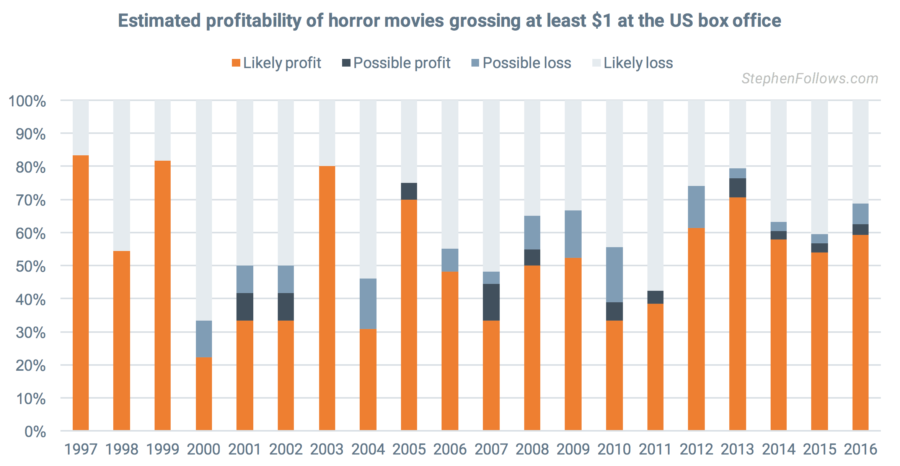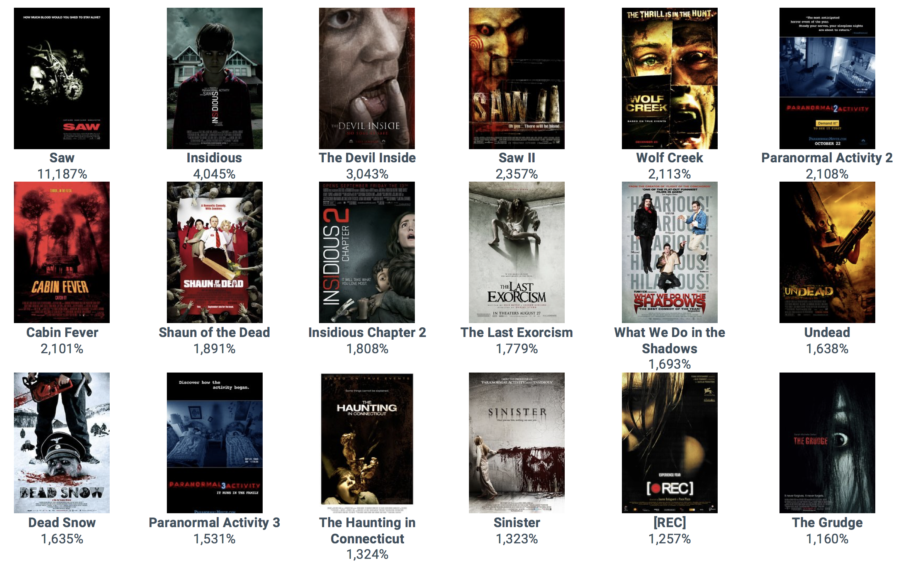 The horror genre is a perennial favourite among filmmakers. The general perception is that they are fun to make, achievable on the lowest budgets and can earn a lot of money.
The horror genre is a perennial favourite among filmmakers. The general perception is that they are fun to make, achievable on the lowest budgets and can earn a lot of money.
The final item on that list normally relies on the assumption that the horror movie in question has a chance to be the next Paranormal Activity or Blair Witch Project, both of which were ludicrously successful and therefore almost certainly highly profitable.
But what of the horror genre more widely? For every runaway success, there are a whole host of flops and failures which make no money and are barely watched by anyone. So with a list of all horror movies, let’s take a look at the average profitability.
This research is just one part of an eighteen-month project I conducted studying all aspects of horror movies. The final result is a 200+ page report. You can learn more and grab your own copy at stephenfollows.com/horrorreport
Profitability is always a tricky topic to cover in the film industry. I have added some more expansive notes at the bottom of this article, but here is a precis of the key caveats:
- Profit calculations. Almost no producer, distributor or exhibitor publishes their private accounts, nor do they share exactly how much their film(s) made. The data for today’s article is a mix of real-world insider data and modelled projections. It comes via my Horror Report project which included every horror movie ever made and from Bruce Nash of The Numbers.
- Films budgeted under $500k are not included. Data on these films has a high chance of being inaccurate and, due to the small figures involved, a small inaccuracy can result in big profitability errors.
- Theatrically released. The horror movies mentioned below have all made it to cinemas in the US. This typically means that they have been acquired by a US distributor, a feat not achieved by all horror movies ever produced.
The overall profitability of horror movies
Across all movies released in US cinemas between 1996 and 2016, horror movies appear to have the highest chance of making a profit, compared to movies within other genres. I estimate that over this period 53% of horror movies released theatrically were likely to have generated profit.
This compares well with the industry average of 37% across all genres, and dramatically outperforms westerns (16% of which are likely to have been profitable), black comedies (28%) drama (31%), and thrillers (32%).

Although this 21-year average is strong when compared to other genres, the figure fluctuates significantly between the years. In the best performing years, 80% of horror releases were likely to have returned a profit, whereas in the worst years the figure falls as low as 22%.
This highlights how dependent the genre is on outliers, and how risky it can be to back a single horror film.

The most profitable types of horror movies
In the Horror Report, I classified all horror movies into a small number of sub-categories. This allows us to see what types and subgenres of films have the highest correlation with profitability.
Found Footage films appear to be the most profitable type of horror movies released, with almost four out of five likely to have made a profit. Conversely, Monster movies have the poorest success rate, with just over a third likely to have generated a profit.

Amongst the hybrid genres, horror comedies and horror romances have the strongest chance to break even, with horror fantasy and horror action films performing the least well.

The most profitable horror movies
Using the Nash dataset, it’s possible to identify the most profitable horror movies between 2000-16, budgeted over $500,000. Profitability is expressed as a percentage return on the reported production budget. I.e. a film which cost $2 million to make and made an eventual profit of $4 million would have a profitability of 200%.

Profitability correlations
In a study for the American Film Market, Bruce Nash and I showed how the critical reception of a horror film has almost no correlation with the profitability of that film. This differentiates horror movies substantially from movies in other genres, where film critics’ perception of the film is a strong barometer of likely profitability.

Conversely, the score given to a film by audiences does have a strong link with that film’s chance of breaking even. Although horror still has the weakest correlation of all genres.

How do horror films make money?
This is a big topic and one I have addressed previously in this blog (including How movies make money: $100m+ Hollywood blockbusters, How films make money pt2: $30m-$100m movies, How is a cinema’s box office income distributed? and Do Hollywood movies make a profit?).
However, to help horror filmmakers, I have taken seventeen unnamed Hollywood horror movies (budgeted $12m-$75m, released in the past fifteen years) and broken down how they made money. Across this dataset, the average movie cost $108 million to make and release, only $31 million of which was the movie’s production budget. The average income received by the studio was $125 million, producing a $17 million profit (i.e. 15.6% of the total cost).

Want to read more?
 The Horror Report contains more detail on the types of horror movies screening on television, as well as covering all other aspects of the film life cycle, right from development through to profitability. The report is sold on a ‘Pay What You Can’ model, meaning that you choose the price you pay.
The Horror Report contains more detail on the types of horror movies screening on television, as well as covering all other aspects of the film life cycle, right from development through to profitability. The report is sold on a ‘Pay What You Can’ model, meaning that you choose the price you pay.
To find out more and to grab a copy of the 200+ page report, please visit stephenfollows.com/horrorreport.
Notes
In this research, profitability was calculated using two datasets:
- The ‘Nash’ dataset. Nash Information Services, LLC (and their public-facing sister site The-Numbers.com) are the film industry’s leading provider of ‘Comp Reports’ for movie business plans and they have kindly shared with me their internal projections of profit and loss for 2,819 movies. They use a variety of sources to provide figures on how much movies have recouped from each part of the film value chain. Producers, investors and organisations use this data to find successful movies comparable to theirs (known as “comps”) to inform their production and investment decisions.
- The ‘Complete’ dataset. This includes the 4,092 horror movies released theatrically in the US between 1996 and 2016 for which there is a budget figure online. I created my own rules of thumb, based on real-world examples and projects, in order to estimate the likelihood that each film reached breakeven after all income and costs were taken into account.
These figures are calculated by Nash Information Services using predictive modelling and real-world data. The profitability figure is estimated by comparing the reported production budget with the estimated final Producer’s Net Profit. Factors which could affect the real-world return include the repayment schedule for investors / creditors, profit participation deals, terms of distribution deals, etc. Therefore, these figures should be seen as approximate.
Films budgeted under $500,000 have been excluded as it is tricky to be confident of their profitability using this model. Their budgets are so low that minor changes in the data can have a dramatic effect on their final profitability figure. This means that profitable micro-budget movies such as Paranormal Activity and The Blair Witch Project do not appear.
Epilogue
I feel I should add a few notes of caution to all filmmakers and film investors thinking that horror movies present an easy source of money:
- Filmmaking is hard and unpredictable. These figures only take into account finished films which reached audiences in some form. If a film does not complete the shoot or post-production work then it’s likely that 100% of the investment will be lost.
- Beware the average. These figures look at overall profitability rates, and the performance of individual films can vary greatly. There is no such thing as “the perfect film investment” and even the surest bet can fail because of unforeseen factors.
- Times change. The film industry is very susceptible to changing tastes and fads, as are audiences (although to a lesser degree). Therefore, even if you make the perfect film for 2017, if it comes out in 2019 then it may be regarded as out of touch and fail to get the necessary industry support to secure full distribution.
Film is rarely a safe career choice or investment opportunity… though in both cases, it can be a fun one!





Comments
Great article Stephen!
Thanks for doing the research and writing it up.
But i have a question please how do you get these info and numbers?
Thanks
A lot of hard research and a little bit of help from people I meet along the way. There are many people in the industry who want to help others but who can’t openly publish data. Therefore, some get in contact with me under the agreement that their names and films are kept private.